A simple, yet lovely art lesson that builds upon the principles of watercolor applications. My fifth grade students used liquid watercolor paints, “black” glue (white school glue mixed with black paint) and 9″ x 12″ 90 lb watercolor paper and a bit of table salt to achieve this lovely watercolor leaves project.
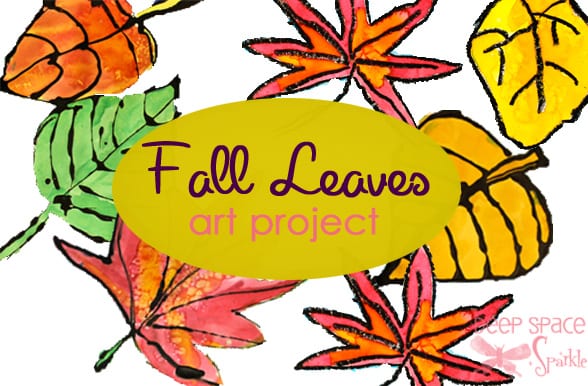
To start, the students drew leaves onto their watercolor paper with a pencil. They used light strokes and tried to capture details. We don’t have fall leaves in Santa Barbara right now, so we used photographs and photocopies of pictures.
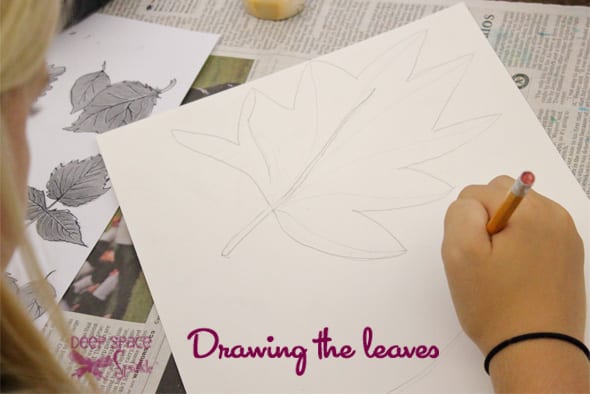
After the drawing, glue was carefully applied to the pencil lines. If a student missed this portion, they could outline their drawings with a black oil pastel, which will give them almost the same look and function (providing a wall for the watercolor paints).
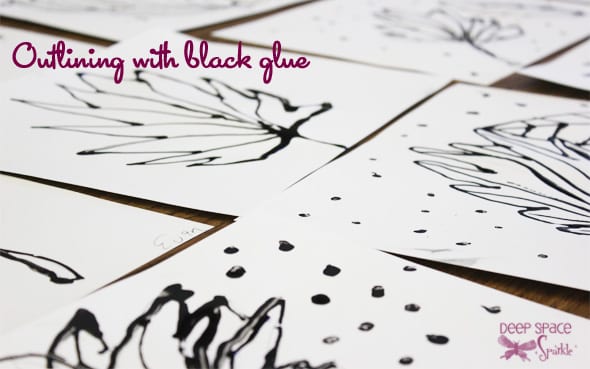
After the glue dries, paint leaves with two to three colors of paints. I stressed mixing colors that were beside each other on the color wheel. For the background, the children painted colors opposite to their leaves. Before the background paint dries, sprinkle a small amount of table salt over the wet surface. The kids can control where they would like to have the sprinkles of salt but encourage a light application. Much easier to remove after the paint dries!
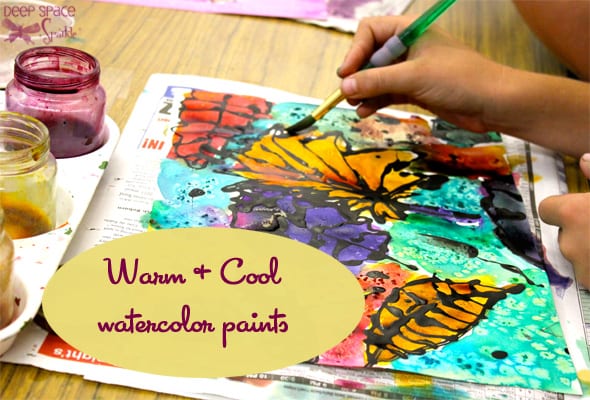
Beautiful Fifth Grade Watercolor Leaves…
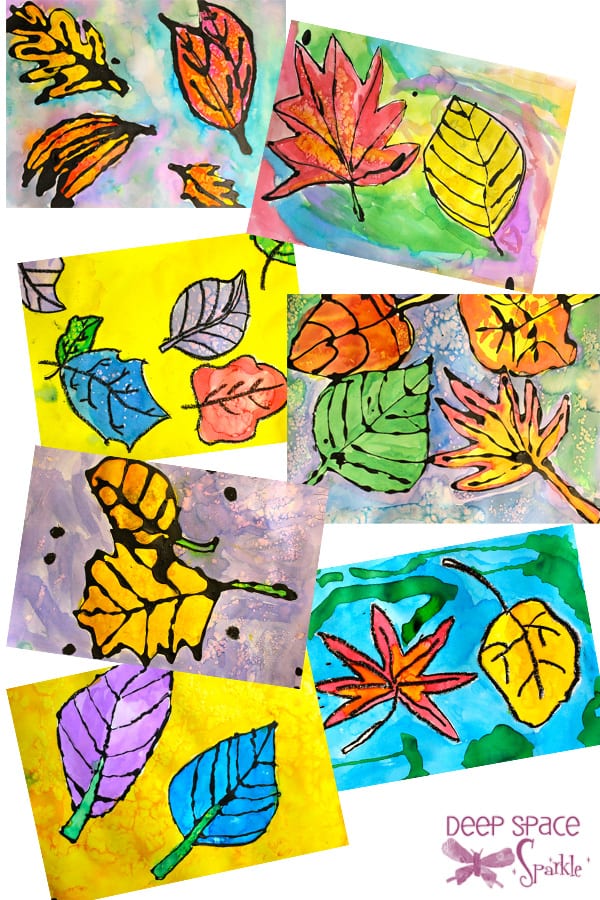
Want more lessons for your fall art activities? Check them out here or try some of these fall leaves projects:
Textured Fall Leaves Art Lesson
The October Freebie pack is chock full of Fall themed lessons, drawing guides, technique tips and video tutorials. Download this handy drawing guide to add to your fall themed art projects this year:












Did you have them use a glue bottle or paint brush to apply the glue?
I use the bottle as the applicator. Never tried a brush. Does it work effectively? I imagine that it would look quite different.
Could be done equally as beautifully as a butterfly for a spring art project.
These are beautiful. I wonder how some of them achieved that “tie-dye” look.
Hi Ana,
Do mean the salt or blending? Perhaps both? Blending colors will offer beautiful results. Have you played with watercolors before?
The fourth and fifth painting have a tie-dye or batik effect. That’s what I was talking about. I haven’t played with watercolors but now that I signed up for your class I hope to learn more about them! 🙂
The batik sort of look is from the salt! When you sprinkle a small amount of salt onto wet watercolor paint, it attracts the pigment & makes a neat effect!
I love the look. What is the ratio of black paint to glue?
Pour enough black paint into the glue until it turns black. Give a good shake! Maybe 1:1. Maybe more glue. Give it a whirl and test it out.
The previous art teacher at our school left several bottles of the blue “gel” glue. I found that it turns black with very little paint added. Just thought I’d share 🙂
Great tip! Thanks.
I am working with elementary school kids who are pretty messy, and do end up getting paint all over the place. I’m a little concerned about using india ink, and probably won’t use that. By black paint, do you mean black tempera or black acrylic? I am hoping to try this project for my 3rd, 4th, and 5th graders. I also have 1st and 2nd graders, so I’m thinking I’ll have them use black pastel or even crayons, or maybe washable marker. I really like having them use observation in drawing. Great project – LOVE your blog!
I used liquid tempera paint to mix with the glue as that is what I have. Someone mentioned using gel glue a sit works better.
I’ve tried lots of variations of this project and love using oil pastels with the little ones. Have fun!
beware, if you use washable markers, they will “bleed” when you add the watercolors because they are water-soluble. You need to use something oil based or wax based, like oil pastels or crayons (I like oil pastels better because crayons require more pressure than many little ones can accomplish effectively), or a permanent marker, which isn’t always advisable with little kids. I’m going to try the glue technique! Little ones love squeezing their own glue and it’s great for building the muscles in their hands that they need for fine motor skills.
Love it!! Did you tie in any artists with this or just science?
No tie-in’s with other curriculum…art techniques and art standards are enough!
I have used India ink and it works great as well. I just did this with my kindergarden class, but i drew the leaves, they turned out great.
Love the black glue with those color combos!
Hi there, I love this project and I’m not sure how I’ll use it yet but I want to experiment myself with it first. What kind of black paint did you use? I don’t have any black paint at home and the freshest type of paint I have right now is watercolor.
does this project take more then one lesson? how long does it take for the glue to dry?
The glue takes about 8 hours. First lesson: drawing + glue. 2nd class: watercolor.
Another way to do this is have them draw the leaves with the white glue and allow to dry. The next day apply the watercolors. Allow to dry. The final step I have done is have students use a fine point black sharpie and draw around every glue line. Looks wonderful!
Love the project, but what happens with the bottles of black glue when their are empty? Do you reuse them for white glue? Wash them out etc.?
You can do what you wish, but I keep these bottles for black glue only. Once you have them, you’ll find lots of uses for black glue.
I am going to do this with my 5th graders when we talk about free-form shapes. How do you keep your students from using too much salt? I tell mine to just sprinkle, but they always go overboard and sometimes they wait too long and ruin the effect.
I don’t try to control the salt but I only give a small container (small restaurant salsa cup) to the table group (4-6 kids to hare). Most instinctively know how much to sprinkle. If they sprinkle too much the only drawback is that its hard to sweep off.
I’m confused…is the salt related to this project? Forgive me, I have a migraine and I’m trying to plan something fun for my son to paint relating to fall. He loves to paint and he’s home schooled so I’m looking for a nice project for us. I just can’t figure out the question Cassie asked about salt and how it’s used in this project? I am no art teacher….maybe I’m missing it. I’ve read and re-read the instructions a few times and I don’t see anything about salt. Help! 🙂
Thanks for sharing this and taking the time to make a blog. This is the best art site I’ve found!
I love this question as it point out my assumption that everyone knows what to do. You are absolutely right! I have no description of salt in my instructions. Here’s what happens: When you add regular table salt to wet watercolor, the salt absorbs the liquid leaving a color stain on the paper. Of course, salt is small, so each little stain mark is hard to see, but when combined with many salt marks, the effects are quite lovely. When the paint dries, the salt can be gently brushed off.
Thanks for the question!
I am a new art teacher and am enrolling in one of your online classes. But how do you get your watercolor paints to be so vivid and thicker looking? When I have worked with watercolor it usually is from the watercolor paints in the regular crayola watercolor paint sets you buy and that is what we have in the art room I work in, but they tend to be not very vivid or weaker even if not as much water is added, so how do you get the paint so much thicker or vivid in color?
Thanks
Which course are you taking? Both courses talk about watercolors and some great tips for teaching children. Have you tried liquid watercolors?
I have inherited some pretty looking watercolor sets that lack pigment and give the students’ painting a faded look but crayola works very well. I just stress to the students to “wake up” the paint by adding a few drops of water first. The paint is vivid when they use a gluey like mix versus a watery mix. I also avoid floppy brushes that hold too much water. There are other little tips as given on this site but crayola has worked very well.
Hi Patty! Your site is amazing and a wonderful resource. I’m planning on this project for a fifth grade class, but I only have about 1.5 hours. If I skip the glue and use black oil pastels, will it look as good? When should the kids trace with the oil pastel? Thanks!
Black oil pastels work great. You can see the artwork where the child used oil pastels on the yellow background and another one blue background. The oil pastel will act as a resist so there is no need for tracing.
This activity looks amazing and I can’t wait to try it with my students tomorrow!! I have just a quick question…how do you suggest the black glue be applied if I do not have any bottles to squeeze it on with? I am working with grade 3 students. Could the glue be applied with a brush or popsicle stick – or any other suggestions?
Thanks so much for your fantastic ideas!
~Cheers.
If you don’t have glue bottles, use black oil pastels. Brushing on the glue defeats the purpose of the glue, as the glue bottle leaves a nice rounded line.
I’m wanting to do this project with my son’s 5th grade class. Do you sprinkle the salt on the background color ONLY or do you sprinkle it on the colored leaves also. Also, apprx. how much time do you think it would take for the black glue to dry before you start painting the leaves?
I love this idea and used it with a tie in to the book Too Much Glue by Jason Lefebvre.
The lesson with warm/ cool colours and paint resist was very well described and should work great with my class. Thank you for sharing.
What fun! I am a quilter and will try this idea on fabric with my dyes!